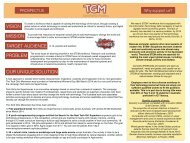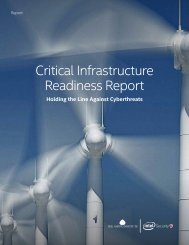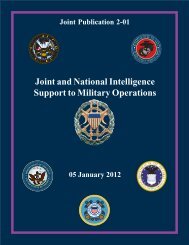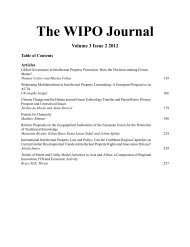Transparency Initiative (EITI)
2eoch1l
2eoch1l
Create successful ePaper yourself
Turn your PDF publications into a flip-book with our unique Google optimized e-Paper software.
35<br />
tation against the <strong>EITI</strong> Standard.<br />
4. <strong>EITI</strong> Secretariat Reviews, produced occasionally as<br />
interim assessments pending Validation.<br />
<strong>EITI</strong> specific and <strong>EITI</strong> procedural aspects are found predominantly<br />
up to output level (covering inputs and activities).<br />
Key features are the:<br />
``<br />
``<br />
``<br />
``<br />
mandatory implementation of an international standard,<br />
which introduces innovations to national and local<br />
debates as it covers the entire decision making chain<br />
in the natural resource sector from licensing to revenue<br />
expenditure.<br />
multi-stakeholder governance model, which includes<br />
among other aspects:<br />
consensual decision making both within stakeholder<br />
groups, e.g. between government departments and government<br />
levels like central/federal and local levels, and<br />
between stakeholder groups, e.g. companies and civil<br />
society organizations.<br />
collective action, which leads to protected space for individuals<br />
and entities in government, companies and<br />
civil society in which critical issues can be addressed,<br />
e.g. political taboos, corruption concerns.<br />
Activities include the following aspects:<br />
1. MSG established.<br />
2. Key stakeholders capacitated.<br />
3. EI framework conditions monitored.<br />
4. Payments reported, reconciliated and disclosed.<br />
5. EI decision chain information disclosed<br />
(e.g. on licensing).<br />
6. Reform processes of the state and for businesses<br />
identified, facilitated and driven by the <strong>EITI</strong>.<br />
Inputs can be summarized as follows:<br />
1. Decisions by the International <strong>EITI</strong> Board to develop,<br />
adjust and enforce the Standard.<br />
2. Political will, services (e.g. preparing data) and financing<br />
(e.g. staff) provided by implementing governments, and<br />
key stakeholders (e.g. in MSG).<br />
3. Services by the International <strong>EITI</strong> Secretariat (e.g. advice,<br />
training, facilitation, research, platform for access<br />
to global open data: https://eiti.org/data).<br />
4. Services and financing by supporting governments,<br />
companies, NGOs, foundations, philanthropists, etc.<br />
(e.g. advice, training, facilitation, research).<br />
5. Research results from academia.<br />
For indicators and variables, and a description of the conditions<br />
that are conducive or obstructive to achieve results,<br />
please see the respective columns in the detailed version.<br />
Objectively verifiable indicators are essential to measure<br />
the benefits to <strong>EITI</strong> stakeholders. They should satisfy internationally<br />
recognized quality criteria (e.g. SMART), however,<br />
they cannot be articulated SMART on a generic level<br />
as they need to catch all contexts. In particular, the same<br />
sources of verification are not given in each country. Sources<br />
of verification of the indicators should be available at<br />
no or little cost to the the <strong>EITI</strong> stakeholders, in order not<br />
to promote a stand-alone approach of <strong>EITI</strong>, but to mainstream<br />
the initiative in governmental and industry processes.<br />
The following special fields of change cannot be adequately<br />
represented in the model:<br />
``<br />
``<br />
International coordination in the field of good governance<br />
in the extractives sector in terms of the G7 lead<br />
for a global level-playing-field, with regards to supply<br />
chain security, fiscal transparency, anti-corruption, Domestic<br />
Resource Mobilization (DRM), etc. A survey of<br />
<strong>EITI</strong> implementation in G7, EU and OECD has shown<br />
that the primary objective of industrialized countries<br />
to opt for domestic implementation is to encourage<br />
“good practice in developing and emerging countries<br />
(especially in relation to good governance, anti-corruption<br />
measures and a level playing field for the private<br />
sector).” Out of this group of countries, only the USA<br />
links <strong>EITI</strong> implementation specifically with its domestic<br />
open government initiatives, the link between implementation<br />
on the one hand and domestic political<br />
objectives and reforms on the other is marginal in all<br />
other cases. Besides the USA, the <strong>EITI</strong> is also linked to<br />
the Open Government Partnership (OGP) in Germany,<br />
Norway and the United Kingdom. “For the most part,<br />
the objectives derived from the work plans are limited<br />
to technical issues concerning viability, reporting and<br />
public relations.” (D-<strong>EITI</strong> 2015: 4).<br />
Government internal communication and cooperation









